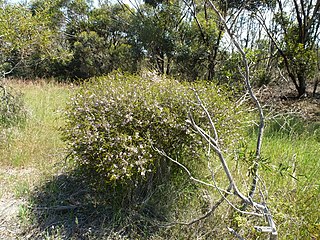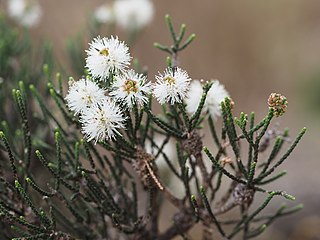
Melaleuca fulgens, commonly known as the scarlet honey myrtle, is a plant in the myrtle family Myrtaceae, and is endemic to Western Australia, South Australia and the Northern Territory. It is notable for its showy orange, red or purple flowers, unusual foliage and fruit, and is a popular garden plant. It is a member of Melaleuca, a large and diverse genus whose members range from large trees such as M. quinquenervia, to small shrubs.

Melaleuca eurystoma is a plant in the myrtle family, Myrtaceae and is endemic to the south of Western Australia. It is a small shrub with pale lemon to greenish flowers and egg-shaped to almost oval leaves.
Melaleuca adenostyla is a plant in the myrtle family, Myrtaceae and is endemic to the south-west of Western Australia. It is a large, broom-like shrub to about 5 metres (16 ft) high with narrow leaves and cream-coloured flowers and which often grows in saline places.
Melaleuca apodocephala is a plant in the myrtle family, Myrtaceae and is endemic to the south-west of Western Australia. It is a low, bushy shrub with crowded, grey-green leaves, corky bark and a profusion of creamy-yellow flowers on the sides of the branches.

Melaleuca araucarioides is a plant in the myrtle family, Myrtaceae and is endemic to a small area of the south-west Western Australia. It is a many-branched shrub with the leaves arranged in a way that gives the plant the appearance of a conifer.
Melaleuca lecanantha is a plant in the myrtle family, Myrtaceae and is endemic to a small area of south-west Western Australia. It is a shrub with small, rather fleshy leaves and pink to lilac-coloured flowers in early spring. The plant was first described in 1867 but the name given to it was considered illegitimate and it was not until 1998 that it was first formally described.

Melaleuca camptoclada is a shrub in the myrtle family, Myrtaceae and is endemic to the south-west of Western Australia. It was first described in 1990 in a review of the genus Melaleuca when the species Melaleuca laxiflora at that time was found to comprise ten species. Two of those species were new - M. camptoclada and M. ctenoides.

Melaleuca conothamnoides is a shrub in the myrtle family, Myrtaceae and is endemic to the south-west of Western Australia. It is distinguished by its relatively large leaves, prominent oil glands and unusual bracts covering the flower buds before they open.

Melaleuca ctenoides is a shrub in the myrtle family, Myrtaceae and is endemic to the south-west of Western Australia. It was first described in 1990 in a review of the genus Melaleuca when the species M. laxiflora at that time was found to comprise ten species. Two of those species were new - M. camptoclada and M. ctenoides. It similar to Melaleuca laxiflora but distinguished from it by its comb-like leaves and attractive mauve or violet flowers in spring.

Melaleuca glaberrima is a plant in the myrtle family, Myrtaceae and is endemic to the south-west of Western Australia. It is a dense, spreading shrub with needle shaped, but not sharp leaves and profuse pink or mauve flowers.

Melaleuca lateriflora, commonly known as gorada, is a plant in the myrtle family, Myrtaceae and is endemic to the south-west of Western Australia. It is usually an erect shrub with oval leaves and small clusters of white flowers mainly along the older branches.
Melaleuca ochroma is a plant in the myrtle family, Myrtaceae, and is endemic to the south-west of Western Australia. It is very similar to Melaleuca subfalcata, varying mainly in the length of its stamens and styles. Like M. subfalcata, it has pink to mauve flowers and leaves that are very hairy when young but become glabrous when mature.
Melaleuca sculponeata is a plant in the myrtle family, Myrtaceae, and is endemic to the south-west of Western Australia. It is a small, rare shrub with fleshy leaves and white heads of flowers.

Melaleuca spathulata is a shrub in the myrtle family, Myrtaceae, and is endemic to the south-west of Western Australia. It is a well known garden shrub featuring dark green leaves against light-coloured foliage, many twisted branches and profuse heads of bright pink "pom pom" flower heads in spring or early summer.

Melaleuca spectabilis is a plant in the myrtle family, Myrtaceae, and is endemic to the south-west of Western Australia. It was formerly known as a subspecies of Melaleuca longistaminea. It is a low, prickly shrub with yellow or lime-green flowers in spring and early summer.
Melaleuca subalaris is a plant in the myrtle family, Myrtaceae, and is endemic to the south of Western Australia. It is distinguished by its small, decussate leaves and small flower heads which rarely have more than one flower in each inflorescence.

Melaleuca suberosa, commonly known as corky-bark honey-myrtle or corky honeymyrtle, is a shrub in the myrtle family, Myrtaceae, and is endemic to the south of Western Australia. It is a distinctive shrub, recognised by its tiny, crowded leaves, corky bark and pink flowers that appear along lengths of leafless parts of the branches.

Melaleuca thyoides, commonly known as salt lake honey-myrtle is a plant in the myrtle family, Myrtaceae and is endemic to the south-west of Western Australia. It is an erect shrub with grey, papery or fibrous bark and very small, overlapping leaves on thin branchlets. It is a salt tolerant species often found on the edges of salt lakes.

Melaleuca ulicoides is a plant in the myrtle family, Myrtaceae and is endemic to the south of Western Australia. It is a small, densely foliaged shrub with small heads of white or cream flowers in spring. It is closely related to Melaleuca marginata but can be distinguished from it by the number and character of leaf veins.
Melaleuca genialis is a plant in the myrtle family, Myrtaceae, and is endemic to the south-west of Western Australia. It is a rare species, known from one nature reserve. It is similar to Melaleuca tinkeri, mainly differing from it in having hairy leaves and petals.













